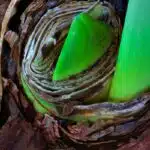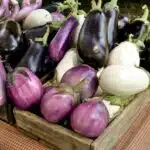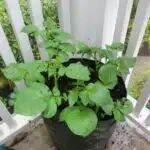Garlic is a staple ingredient in many cuisines around the world, and growing your own garlic can be a rewarding experience. However, choosing the right type of garlic to grow can be overwhelming for those new to gardening or horticulture. As a horticulture specialist, I have seen many gardeners struggle with selecting the right garlic variety for their needs. In this article, we will explore the factors to consider when choosing a garlic to grow, including the type of soil, climate conditions, and desired flavor profile.
When it comes to growing garlic, selecting the right variety is essential. The type of garlic you choose will impact both the flavor of your final product and how well it grows in your specific region. There are two main types of garlic: softneck and hardneck. Softneck garlic typically has more cloves per bulb and stores better than hardneck varieties. Hardneck varieties tend to have larger cloves and are known for their unique flavors. Consider your desired end-use for the garlic when selecting which type to grow. Additionally, there are numerous cultivars within each type of garlic that vary in flavor intensity and growth habits. In this article, we will delve into these factors in greater detail so you can make an informed decision on which garlic variety is best suited for your garden and culinary endeavors.
Understanding The Types Of Garlic
Garlic is a commonly used ingredient in many cuisines worldwide, from Italian to Chinese. Growing garlic seed is an excellent choice for home gardeners who want to have a fresh supply of this flavorful bulb. However, not all garlic varieties are created equal, and choosing the right one is crucial for success.
When selecting garlic seed, it’s essential to know the two main types: softneck and hardneck garlic. Softneck garlic has a pliable stem that can be braided into garlands, while hardneck garlic has a stiff central stem with fewer cloves but larger sizes. Both types have their advantages and disadvantages when it comes to planting techniques and growing conditions.
Softneck garlic varieties tend to grow better in warmer climates and have more cloves per bulb than hardneck varieties. They are also easier to braid and store due to their flexible stems. On the other hand, hardneck garlic prefers colder weather conditions and can produce larger individual cloves with richer flavors than softneck varieties. Understanding these differences will help you choose the right type of garlic for your growing conditions and cooking needs.
As we delve deeper into understanding the different types of garlic available for planting, it’s important to distinguish between softneck vs. hardneck garlic. This distinction will help us determine which type is best suited for our specific gardening conditions and how we can optimize our planting techniques accordingly.
Softneck Vs. Hardneck Garlic
Understanding the Types of Garlic is essential before choosing which variety to grow. As a horticulture specialist, it is crucial to know that garlic comes in two main types: softneck and hardneck. Softneck garlic has a more extended shelf life and is easier to braid for storage, while hardneck garlic produces scapes that can be used in culinary dishes.
When deciding which type of garlic to grow, there are several factors to consider. Firstly, think about the intended use of the garlic. If you plan on using it mainly for cooking, then softneck garlic may be the better option due to its longer shelf life. However, if you plan on incorporating the scapes into your culinary dishes or want a stronger flavor profile, then hardneck garlic may be more suitable.
Another factor to consider when choosing garlic is your climate and growing conditions. Hardneck garlic tends to do better in colder climates as it needs a winter dormancy period, while softneck varieties thrive in warmer climates. Additionally, soil quality and drainage should also be taken into account when selecting which variety to grow.
Overall, understanding the types of garlic and considering factors such as culinary uses and growing conditions are essential when choosing which variety of garlic to grow. In the next section, we will discuss further factors that should be considered when selecting specific types of garlic for planting.
Factors To Consider When Choosing Garlic
When choosing garlic to grow, there are several factors one should consider. First and foremost, it is important to select a variety that will thrive in your growing zone. Garlic is typically divided into two categories: hardneck and softneck. Hardneck varieties tend to be better suited for cold climates, while softneck varieties are more adaptable to warmer regions.
Another factor to consider when choosing garlic is the growing techniques you plan to use. Whether you opt for traditional in-ground planting or container gardening will dictate which varieties are best suited for your needs. Additionally, some growers prefer to use organic methods, while others rely on chemical fertilizers and pesticides.
Finally, it is important to think about the harvesting methods you plan to use. Some gardeners prefer to harvest their garlic when the tops of the plants begin to turn brown, while others wait until the plants have completely dried out before harvesting. Regardless of your preferred method, it is important to handle your garlic with care during the harvesting process in order to prevent damage.
Moving forward into our next section on climate conditions, it’s important to note that selecting the right variety of garlic can have a significant impact on how well it performs in different weather conditions. By taking these factors into account when choosing which type of garlic to grow, you can increase your chances of success and enjoy a bountiful harvest come harvest time.
Climate Conditions
While garlic is a versatile crop that can be grown in different climates, it is important to choose the right variety based on your location. Some people may argue that garlic can be grown anywhere, regardless of the climate. However, this is not entirely true. Like any other plant, garlic has specific climate requirements that must be met for it to grow optimally.
To ensure successful growth, consider the following factors when selecting a garlic variety:
- Temperature: Garlic grows best in cooler temperatures between 13°C and 24°C. In areas with high temperatures, consider planting in the fall or winter to avoid extreme heat stress.
- Humidity: Garlic prefers moderate humidity levels of around 70%. Ensure proper ventilation and irrigation to prevent fungal diseases.
- Day length: Garlic requires a certain number of daylight hours to form bulbs. Short-day varieties require less than 12 hours of daylight while long-day varieties need more than 12 hours.
Growing techniques and harvesting methods also play a crucial role in determining the success of your garlic crop. Proper spacing, fertilization, and watering are key growing techniques that will promote healthy growth and bulb formation. Harvesting methods vary depending on whether you are growing softneck or hardneck garlic varieties. Softneck garlic can be harvested when the tops begin to yellow while hardneck garlic should be harvested when about half of the leaves turn brown.
With these considerations in mind, you can select a suitable garlic variety based on your climate conditions and maximize your chances of success when growing this versatile crop. In the subsequent section, we will cover soil type and quality as another important factor to consider when growing garlic.
Soil Type And Quality
Soil Type and Quality:
A crucial factor in growing garlic is soil preparation. Garlic requires well-draining soils with high organic matter content to promote root growth and discourage pests and diseases. The ideal soil pH level for garlic cultivation is between 6.0-7.0, which means the soil is slightly acidic to neutral.
Before planting, it is important to amend your soil with compost or aged manure to provide essential nutrients that garlic needs to grow healthy bulbs. Soil preparation can also help improve drainage by loosening compacted soils, which aids in water absorption and penetration. It is best to prepare the soil several weeks before planting to allow time for the organic matter to break down and release nutrients into the soil.
To determine whether your soil has the proper pH level for garlic cultivation, you can test it using a simple home testing kit or by sending a sample of your soil to a local agricultural extension office. If your soil pH level falls below 6.0 or above 7.0, you may need to adjust it accordingly by adding lime or sulfur.
| Soil Type | Ideal pH Level |
|---|---|
| Sandy Loam | 6.2-7.0 |
| Clay Loam | 6.0-7.0 |
| Silty Loam | 6.2-7.0 |
| Peat Soils | 5.5-6.5 |
| Muck Soils | 5.8-7.0 |
Incorporating these recommendations into your soil preparation will ensure that you are setting up an optimal environment for growing garlic successfully and producing healthy bulbs with desirable flavor profiles, as we will explore in the subsequent section about desired flavor profiles of garlic varieties based on regional differences in their growth conditions and cultivars used for propagation purposes.”
Desired Flavor Profile
Just as soil quality is crucial to the growth of garlic, flavor preference is equally important when choosing a garlic cultivar. Different varieties of garlic offer distinct flavors and culinary uses that can enhance any dish. As a horticulture specialist, it’s important to consider the desired flavor profile of your customers when selecting which garlic to grow.
Garlic flavor preferences vary widely among consumers. Some prefer a strong and pungent taste, while others prefer a milder flavor with hints of sweetness. It’s essential to understand your clientele’s preferences and choose a cultivar that satisfies their needs. For example, if you’re catering to Italian cuisine enthusiasts who love bold flavors, then growing an Italian Purple Stripe cultivar might be the best option. On the other hand, if you’re serving customers who enjoy more subtle tastes, then planting a Silver White or Rosewood cultivar may be more appropriate.
Culinary uses should also be considered when selecting a garlic variety. Some types of garlic are better suited for roasting and baking because they have less heat and a sweeter aftertaste, while others are ideal for raw dishes such as salads or pesto sauces because they have a stronger flavor profile. By taking into account both flavor preference and culinary use, you can provide your customers with high-quality and flavorful garlic that will elevate their cooking experience.
Transitioning into the subsequent section about ‘garlic cultivars,’ we will explore the different types available in greater detail so that you can make an informed decision on which one to grow for your specific clientele’s needs. Each cultivar has unique characteristics that make them suitable for specific culinary applications and climates, ensuring that you find the perfect garlic type for your garden or farm without compromising on taste or quality.
Garlic Cultivars
When choosing a garlic cultivar to grow, there are many factors to consider. One of the most important is yield. While all garlic plants will produce bulbs, some varieties have been bred specifically to maximize their yield potential. For best results, look for garlic cultivars that are known for producing large, well-formed bulbs. Softneck varieties tend to be the highest yielding, though some hardneck types can also produce impressive harvests.
Another factor to consider when selecting a garlic variety is pest resistance. Garlic is generally considered a low-maintenance crop, but it can still fall victim to pests and diseases like onion maggots and white rot fungus. By choosing a variety that is naturally resistant to these problems, you can reduce your risk of crop failure and ensure a more successful harvest. Some popular pest-resistant varieties include Inchelium Red and Chesnok Red.
When selecting a garlic cultivar for your garden or farm, it’s important to weigh all of these factors carefully before making your decision. Consider the growing conditions you’ll be working with, as well as your own personal preferences in terms of flavor and cooking style. By taking the time to choose the right variety for your needs, you’ll be setting yourself up for success in the coming growing season.
Transitioning into the subsequent section about flavor intensity: Of course, yield and pest resistance aren’t the only factors that matter when it comes to choosing a garlic cultivar – flavor intensity plays an important role as well. In the following section, we’ll take a closer look at how different varieties stack up in terms of taste and aroma, so you can choose the one that’s perfect for your palate.
Flavor Intensity
Garlic cultivars come in different shapes, sizes, and colors. The decision on what garlic to plant depends on many factors such as flavor intensity, planting season, and growth habit. However, the most important thing to consider is your personal preference.
When it comes to choosing a garlic cultivar based on flavor intensity, there are three main categories: mild, medium, and strong. Mild garlic has a subtle taste that is perfect for dishes where garlic is not the main ingredient. Medium garlic has a more noticeable flavor but still retains its sweetness when cooked. Strong garlic has a pungent taste that can overpower other flavors but adds depth to dishes like soups and stews.
Garlic planting plays a significant role in flavor development. The soil type, climate condition, and fertilization technique used all influence the taste of the garlic bulb. For instance, sandy loam soil produces sweeter bulbs than clay soil. Additionally, cold temperatures stimulate sulfur production in garlic which contributes to its flavor intensity.
As gardeners or farmers who have a subconscious desire for serving others with quality produce, we must carefully select our garlic cultivars based on our planting conditions and personal preferences. With this knowledge about flavor intensity and how it relates to planting techniques, we can ensure that our customers receive the best product possible. In the next section, we will explore growth habits and their importance in selecting the right garlic cultivar for your farm or garden.
Growth Habits
Garlic plants are typically grown in the fall, during which they require a cool period to grow properly. During this time, it is important to provide adequate water and fertilizer for the plant to grow. As the weather warms up, growth will slow down and eventually stop. This is when garlic bulbs begin to form.
In terms of growing techniques, garlic plants prefer well-drained soil with a pH level of 6.0-7.0. The soil should be loose and fertile, with plenty of organic matter added in prior to planting. It is also important to space garlic bulbs out properly, as overcrowding can lead to smaller bulbs.
Harvest timing is crucial when it comes to growing garlic. Once the leaves start turning yellow or brown and begin falling over, it is time to harvest the bulbs. It is best to dig them up gently with a fork or shovel rather than pulling them out by hand, as this can damage the bulbs.
By understanding the growth habits of garlic plants and implementing appropriate growing techniques and harvest timing, gardeners can produce healthy and flavorful garlic crops year after year. With these factors in mind, making an informed decision about which variety of garlic to grow becomes much easier.
Making An Informed Decision
When choosing a garlic variety to grow, there are several factors to consider. Firstly, it is important to determine the purpose of growing garlic. Different varieties have varying characteristics that may suit different purposes such as culinary use or medicinal properties. Secondly, the climate and soil conditions of the planting site should be taken into consideration as some varieties thrive in specific environments. Lastly, one should also consider their level of experience in garlic cultivation as some varieties require more advanced growing techniques.
Understanding the different types of garlic varieties is crucial in making an informed decision. Softneck garlic is commonly used for culinary purposes due to its mild flavor and longer shelf life. Hardneck garlic, on the other hand, has a stronger flavor and is often used for medicinal purposes. Additionally, elephant garlic produces large bulbs with a milder taste compared to traditional garlic.
The success of growing garlic does not only rely on choosing the right variety but also on proper cultivation techniques. Garlic prefers well-draining soil with moderate moisture levels and requires regular watering during dry spells. It is best planted in fall or early spring and should be provided with adequate sunlight exposure. Incorporating organic matter into the soil can also improve nutrient uptake and increase bulb size.
- A well-draining soil promotes healthy root growth and prevents waterlogging.
- Adequate sunlight exposure ensures optimal photosynthesis for bulb development.
- Regular watering during dry spells maintains consistent moisture levels in the soil.
- Adding organic matter into the soil improves nutrient uptake and increases bulb size.
In summary, selecting a suitable garlic variety involves considering its intended use, environmental requirements, and personal expertise in cultivation techniques. Proper growing methods such as providing adequate sunlight exposure and moisture levels will increase the likelihood of a bountiful harvest. By making an informed decision when selecting a variety and implementing proper cultivation techniques, one can enjoy homegrown garlic that meets their specific needs without compromising quality or flavor.
Conclusion
Garlic is a versatile and widely used ingredient in the culinary world. Choosing the right type of garlic to grow can make all the difference in the flavor and quality of your dishes. Understanding the differences between softneck and hardneck varieties, as well as considering factors such as climate, soil type, and garlic cultivars are important when making your selection.
When choosing between softneck and hardneck garlic, it is important to note that hardneck varieties are more suited for colder climates while softneck varieties thrive in warmer regions. Additionally, factors such as soil quality and type can greatly affect the growth of garlic. It is recommended to test your soil before planting to ensure optimal growing conditions.
One interesting statistic to consider is that there are over 600 cultivars of garlic worldwide. This highlights the vast diversity within this crop and emphasizes the importance of selecting the right variety for your specific needs. By taking into consideration all relevant factors when choosing a garlic variety to grow, you can ensure a successful harvest and delicious flavors in your cooking endeavors.
Image Credits
- “Garlic Bread” by mdid (featured)





























